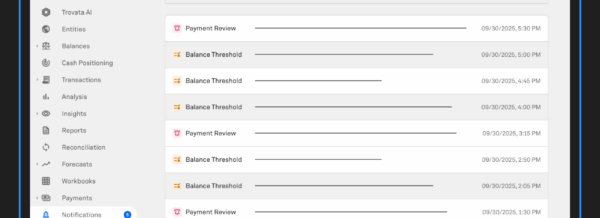The role of the corporate treasurer is rapidly evolving. Once focused primarily on managing cash and liquidity, today’s digital treasurer is a strategic advisor who uses rich data to uncover unique insights and enhance corporate decision making.
Business (and the world in general) is getting more complex all the time, and digital transformation is key to managing that complexity. This shift toward digital treasury allows treasurers to access real-time data, automate routine tasks, and enhance their strategic influence within the organization.
In this article, we’ll look at how treasurers can thrive in this new environment, the essential skills they need to develop, and the key technologies that are shaping the future of treasury management.

The Shift Toward Digital Treasury
The treasury function is undergoing a transformation as technological advancements redefine how finance teams operate. Words like ‘transformation’ and ‘redefine’ can be overused in the corporate world, but in this case they aren’t hyperbole, describing exactly how much of a change is happening.
Traditional manual processes are being replaced by automated, data-driven solutions that provide greater accuracy, speed, and insight. At the same time, treasurers and their teams are gaining access to data that allows them to understand their organizations at a level that has simply not been possible in the past.
However, many treasurers still struggle with navigating this new landscape. In fact, according to Deloitte’s 2024 Global Treasury Survey, treasurers listed digital capabilities as the second most significant challenge faced by their organizations. So can you lead digital transformation within your organization?
Let’s get specific on exactly how technology is changing and enhancing the way treasury teams operate.
How Tech is Transforming Treasury Functions
Let’s start with the day-to-day. Digital transformation is making treasury operations more efficient, flexible, and scalable. How? The rise of open banking APIs, automation, and AI is enabling treasurers to gain real-time visibility into their cash position and transactions and automate manual tasks like data normalization or standard reporting.
Enhanced Connectivity
For example, APIs have become more standardized, allowing seamless connections between banks and treasury platforms, enabling faster data retrieval and better cash management.
No more expensive and time-consuming bespoke data connections, file-based data transfers that occur once per day, and no need to manually export, normalize and consolidate data.
Advanced Analytics and Reporting
This real-time view of your cash, along with advanced data analytics and cloud-native functionality, are becoming indispensable tools for the modern treasurer. Real-time data allows for instant visibility into cash positions across global accounts, while cloud-native platforms provide scalability and flexibility.
As well as better data for humans to review, AI can also be used for predictive analytics, helping treasurers to anticipate cash flow trends, automate forecasting, and optimize liquidity.
Simplified Payments and Accounts
With auto-maching of transactions and the ability to originate payments from any one of the company’s bank accounts on a single platform, modern treasury tech makes it easier to pay vendors and complete the month-end close.
In short, tech allows treasury and finance teams to access more data, more quickly and more efficiently. From there, it enables far deeper analysis, data manipulation and forecasting than traditional treasury methods. All that adds up to more informed decision making, and far more efficient and scalable processes.
Digital Treasurer vs. Traditional Treasurer
In fact, the role is changing so much that it’s not even really the same job that was being done 20+ years ago.
The role of the digital treasurer is distinctly different from that of a traditional treasurer. Today’s digital treasurers are not just managing cash; they’re strategic advisors who leverage technology to drive business growth.
It’s not simply about looking at the past, it’s become more and more about looking at the future. Providing insights and advice on how to manage cash and cash flow not just today, but in one, five and ten years time.
This evolution is sometimes referred to as Treasury 4.0, where real-time insights, automation, and strategic decision-making are at the forefront.
Essential Digital Skills for Treasurers
To succeed as a digital treasurer, finance professionals need to develop a range of digital skills that go beyond traditional treasury management.
1. Data Analysis and Financial Modeling
Modern treasury requires the ability to interpret large datasets quickly and accurately. Treasurers who can use AI-driven tools to build financial models, predict cash flow, and analyze spending patterns will have a significant advantage in decision-making.
The key shift here is away from the knowledge of how to build a baseline model (where modern treasury tools can do much of the heavy lifting), and more towards strategic understanding of how different levers can impact outcomes.
To put it another way, modern treasurers need to weigh their knowledge and skill towards understanding the outputs of a financial model or data set, rather than the inputs.
2. API Integration Knowledge
Understanding how APIs work and their impact on multi-bank data is an important piece of knowledge for digital treasurers. APIs enable seamless data exchange between banking systems and treasury platforms, allowing for better cash visibility, faster payments, and efficient data management.
This isn’t necessarily about needing a detailed technical understanding of APIs, but Treasurers should know how they differ to traditional connectivity methods, and how integration can be used within the business to improve data management.
APIs are the future for Treasury 4.0, so modern Treasurers should have the knowledge to understand where they fit in their organization.
3. Advanced Cash Forecasting and Scenario Planning
It’s obvious that cash forecasting and scenario planning is a must for modern treasury teams. But there’s forecasting, and then there’s forecasting.
Digital treasurers shouldn’t be satisfied with a basic Excel spreadsheet. Advanced cash forecasting tools and scenario planning software offer the ability to model different financial outcomes, update using real-time data, and manage complex multi-entity organizations at various levels.
These tools help anticipate risks and identify opportunities, ensuring companies are always prepared for potential changes.
4. Cybersecurity Awareness and Compliance
It’s a given that the more treasury operations move to the cloud, the higher a priority cybersecurity becomes. It’s an area that is never static. There are constant new threats to online security, and new security and data protection measures designed to neutralize them.
Treasurers must be aware of the ever-changing best practices in data security and compliance, to ensure that their sensitive financial information is protected across digital platforms.
Key Tools for the Digital Treasurer
The skills and knowledge we’ve discussed are really only useful when combined with the right software and technology. Here are some key tools that every digital treasurer should consider:
1. Modern Treasury Management Platforms
Treasury management platforms like Trovata help centralize data from multiple banks, providing real-time cash visibility and automating routine tasks like cash reporting. These platforms simplify multi-bank connections through open banking APIs, enabling finance teams to manage cash more efficiently.

While a legacy Treasury Management System (TMS) can offer connectivity options and some basic forecasting functionality, they fall short of the flexibility and scalability of a modern treasury management platform. On paper, the functionality can look similar, but the reality is far different.
Payment automation is a perfect example of this.
2. Payment Centralization and Automation
Automating payments and transaction matching reduces errors, speeds up account reconciliation, and provides greater control over cash flow. Tools that centralize payment processes across different regions and banks make it easier for treasurers to track and manage payments, ensuring that all transactions are secure and efficient.

This is a great example of the real world difference between technology and functionality of a legacy TMS and a modern treasury platform.
Using traditional file-based methods, auto-matching rates can be as low as 20% for a legacy TMS. For an API-based connection, that figure rises to almost 100%. So, while they both technically offer transaction automation, the real world experience is far better with a modern solution like Trovata.
3. Cloud-Native Solutions
Cloud-native platforms are scalable, flexible, and accessible from anywhere. By migrating to cloud-native solutions, treasurers can streamline operations, reduce costs, and ensure their systems are always up-to-date.
There’s an important distinction to be made between cloud-based systems which have been adapted from on-premises infrastructure, to cloud-native software applications which are designed from the ground up specifically for deployment in public or private clouds using a microservices architecture.
The latter provides better scalability, flexibility, and security features compared to traditional monolithic systems hastily ported to the cloud environment.
4. Generative AI Analysis Tools
Generative AI can process and analyze vast amounts of data, providing insights that would be difficult to uncover manually. From detecting anomalies in spending patterns to forecasting cash flow, AI enables more strategic decision-making by delivering actionable insights in real time.

Features like Trovata don’t replace the skills and knowledge of a real finance or treasury professional, but they can vastly improve the efficiency and accuracy of their work.
Career Development for the Digital Treasurer
None of this is static. The right knowledge and tools to upskill yourself on today, isn’t necessarily going to be the same five years from now. To stay competitive, treasurers must be willing to adapt, upskill, and embrace new ways of thinking.
Here are three of the key requirements to staying ahead of the pack:
1. Developing a digital mindset – Treasurers should always be looking for ways to leverage technology. It’s not about “this is how we’ve always done it,” but instead “how can we make this better or easier?”
2. Keeping a pulse on tech advancements – Find publications, LinkedIn profiles, company blogs and events that are intricately involved in the future of treasury tech.
3. Try new tools – Be ready to get your hands dirty and try new tools. From a career development standpoint, this should include seeking out roles at companies which place a high priority on digital transformation. This will provide exposure to technology that will enhance your value to other organizations in the future.
In fact, many finance workers are increasingly seeing technology upskilling as a key aspect to selecting their employer.
Embrace the Digital Future
The digital transformation of treasury functions is well underway, and treasurers who embrace this change will be better equipped to navigate the complexities of modern finance. By developing the right digital skills and adopting cutting-edge tools, treasurers can future-proof their careers and drive more strategic value within their organizations.
Trovata combines all the fundamental components of a modern treasury tech stack into a single platform. The API-first multi-bank data lake and sophisticated visualization and forecasting tools allow teams to see their cash and financial data in real-time, and analyze it in more ways than has ever been possible.

Trovata’s use of open banking APIs isn’t limited to just seeing financial data, it can also be used to initiate payments too. That saves teams from having to initiate these payments from multiple portals, allowing for total cash management on a single platform.

Explore how Trovata’s digital solutions can help you enhance your treasury operations, and take the next step in becoming a digital treasurer. Book a demo today.




